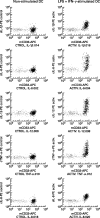Extensive characterization of the immunophenotype and pattern of cytokine production by distinct subpopulations of normal human peripheral blood MHC II+/lineage- cells
- PMID: 10594557
- PMCID: PMC1905448
- DOI: 10.1046/j.1365-2249.1999.01078.x
Extensive characterization of the immunophenotype and pattern of cytokine production by distinct subpopulations of normal human peripheral blood MHC II+/lineage- cells
Abstract
Dendritic cells (DC) represent the most powerful professional antigen-presenting cells (APC) in the immune system. The aim of the present study was to analyse, on a single-cell basis by multiparametric flow cytometry with simultaneous four-colour staining and a two-step acquisition procedure, the immunophenotypic profile and cytokine production of DC from 67 normal whole peripheral blood (PB) samples. Two clearly different subsets of HLA-II+/lineage- were identified on the basis of their distinct phenotypic characteristics: one DC subset was CD33strong+ and CD123dim+ (0.16 +/- 0.06% of the PB nucleated cells and 55.9 +/- 11. 9% of all PB DC) and the other, CD33dim+ and CD123strong+ (0.12 +/- 0.04% of PB nucleated cells and 44.53 +/- 11.5% of all PB DC). Moreover, the former DC subpopulation clearly showed higher expression of the CD13 myeloid-associated antigen, the CD29 and CD58 adhesion molecules, the CD2, CD5 and CD86 costimulatory molecules, the CD32 IgG receptor and the CD11c complement receptor. In addition, these cells showed stronger HLA-DR and HLA-DQ expression and a higher reactivity for the IL-6 receptor alpha-chain (CD126) and for CD38. In contrast, the CD123strong+/CD33dim+ DC showed a stronger reactivity for the CD4 and CD45RA molecules, whereas they did not express the CD58, CD5, CD11c and CD13 antigens. Regarding cytokine production, our results show that while the CD33strong+/CD123dim+ DC are able to produce significant amounts of inflammatory cytokines, such as IL-1beta (97 +/- 5% of positive cells), IL-6 (96 +/- 1.1% of positive cells), IL-12 (81.5 +/- 15.5% of positive cells) and tumour necrosis factor-alpha (TNF-alpha) (84 +/- 22.1% of positive cells) as well as chemokines such as IL-8 (99 +/- 1% of positive cells), the functional ability of the CD123strong+/CD33dim+ DC subset to produce cytokines under the same conditions was almost null. Our results therefore clearly show the presence of two distinct subsets of DC in normal human PB, which differ not only in their immunophenotype but also in their functionality, as regards cytokine production.
Figures





References
-
- Steinman RM. The dendritic cell system and its role in immunogenicity. Annu Rev Immunol. 1991;9:271–96. - PubMed
-
- Knight SC, Stagg AJ. Antigen-presenting cell types. Curr Opin Immunol. 1993;5:374–82. - PubMed
-
- Levin D, Constant S, Pasqualini T, Flavell R, Bottomly K. Role of dendritic cells in the priming of CD4+ T lymphocytes to peptide antigen in vivo. J Immunol. 1993;151:6742–50. - PubMed
Publication types
MeSH terms
Substances
LinkOut - more resources
Full Text Sources
Medical
Research Materials
Miscellaneous

